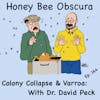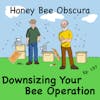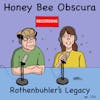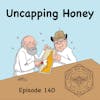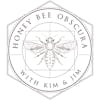How Phenology Can Help Your Manage Bees (095)

Does your state Agriculture Department have a bulletin they share with everybody on the phenology, or bloom dates, of the wild flowers, trees and shrubs that grow in your state? Today Kim and Jim discuss the chart used by Ohio beekeepers. Ohio’s...
Does your state Agriculture Department have a bulletin they share with everybody on the phenology, or bloom dates, of the wild flowers, trees and shrubs that grow in your state?
Today Kim and Jim discuss the chart used by Ohio beekeepers. Ohio’s chart shows what is blooming each month, the adult and larvae bee population in a hive, and what beekeepers should be doing relative to space management in their hives.
It’s a great tool to have for beekeepers in your state so they can know ahead of time what they should expect relative to bloom and room in a hive.
A phenology chart is a good guide, but bloom dates are affected by temperature, moisture and photo period. Knowing that, a beekeepers should be keeping track of the microenvironment his or her hives are located to see if the chart is accurate where they are. A phenology chart is a good tool to help guide your management plan.
We hope you enjoyed today's episode. Please follow or subscribe today and leave a comment. We'd love to hear from you!
The .pdf file of the Beekeeper's calendar can be downloaded here: https://www.dropbox.com/sh/xbtj9x1t53iytz9/AAD79pFc--jgv8Zvcag-FpEta?dl=0
___________________
Thanks to Betterbee for sponsoring today's episode. Betterbee’s mission is to support every beekeeper with excellent customer service, continued education and quality equipment. From their colorful and informative catalog to their support of beekeeper educational activities, including this podcast series, Betterbee truly is Beekeepers Serving Beekeepers. See for yourself at www.betterbee.com
______________________
Honey Bee Obscura is brought to you by Growing Planet Media, LLC, the home of Beekeeping Today Podcast.
Music: Heart & Soul by Gyom, All We Know by Midway Music, original guitar music by Jeffrey Ott
Copyright © 2022 by Growing Planet Media, LLC

Episode 95 – How Phenology Can Help Your Manage Bees
[music]
Jim Tew: Kim, I just drove all the way to Central Alabama, to go to their 100th-anniversary meeting of the state organization. When the meeting was over, I got back in my car and I drove the return 890 miles home or so. The entire way I was intrigued to watch Goldenrod in various stages of blooming, or fading, depending on what the case may have been.
Kim Flottum: Well, it makes perfect sense this time of year. I got a phenology chart here for Ohio, and I'm looking at that, and it says Goldenrod should be blooming in September. Bingo.
Jim: I love the part where you say perfect sense. Like you see something I don't see. I hope you don't mind talking about this for the next 15 minutes or so. Let's just see how things bloom. Are you okay with it?
Kim: I am.
Jim: All right. Hi, I'm Jim Tew.
Kim: I'm Kim Flottum.
Jim: We're here at Honey Bee Obscura, where our chosen topic of the day is the phenology of the plants that could benefit our bees.
Introduction: You're listening to Honey Bee Obscura, brought to you by Growing Planet Media, the folks behind Beekeeping Today podcast. Each week on Honey Bee Obscura hosts Kim Flottum, and Jim Tew explore the complexities, the beauty, the fun, and the challenges of managing honey bees in today's world. Get ready for an engaging discussion to delight and inform all beekeepers. If you're a longtimer or just starting out, sit back and enjoy the next several minutes as Kim and Jim explore all things honey bees.
Jim: First off, Kim, what is a phenology chart?
Kim: Well, basically it's a chart that shows when plants bloom on a calendar basis. It lays out the whole year, starting in January and ending in the end of December. It will name a plant. I'm just looking at one here. Let's say locust. On this phenology chart, locust just begins blooming, it says in the middle of May, and it will taper off almost by the end of June. It's in full bloom right at the end of May and the beginning of June. I've got that for all of the plants, all of the major honey plants in Ohio.
What that does, is it gives me a heads up of what to prepare for. What you got to know is how much honey are locusts going to make, compared to dandelions or milkweed, or any of those things, so that you can get your supers on. Honey supers on ahead of schedule instead of always being behind the eight ball and getting them on in time.
Jim: This supering thing you're talking about is a honey production procedure. Are we also concerned about swarming and queen replacement in the middle of all this? This phenology chart represents a tool that beekeepers could use in the honey production aspect of their beekeeping enterprise?
Kim: Well, it does. Just to back up a half a step. I know Ohio has a phenology chart. In fact, I worked with the people who helped produce it back when I was the editor. We had a phenology garden in the back of our office there. Every state is going to have something along these lines or even if your state doesn't, I'm going to bet you can find the state next door. It's going to be close in terms of both temperature and soil type. All of these things affect bloom date, a temperature is going to be primary, north and south is going to be a little bit different, east and west is going to be closer usually. Take a look, if you're looking for one in your state, Google phenology chart Ohio and see what you find.
Jim: You would Google phenology chart and their particular state, wouldn't you?
Kim: Exactly.
Jim: Because a beekeeper from New Mexico might have a passing interest in what we're doing here in Northeast Ohio, but I'll bet you that the plants all through New Mexico and Arizona and their blooming dates are going to be remarkably different than what's here. It's just a tool, right? It's just an almanac in a way, an estimation of blooming dates.
Kim: It gives you the ability to look ahead in time and you can then say, okay, I'm not going to have to worry too much about adding extra supers for the next two or three weeks because not much is going to be coming in. You take a look at the weather, is the weather about average, you can do that. Now they predict weather ahead of time and temperature ahead of time. Now, this thing will tell you given all of that about when these plants are going to bloom. It's exactly right. It's a tool. It's one more tool to make life better for the beekeeper, and actually better for the bees because if you don't get supers on time, they don't have enough room, and you mentioned swarming.
Jim: Yep, but you're giving me a headache here because I'm trying to think what all of the morass of responsibility that a conscientious beekeeper faces, trying to manage their bees, so you want to get the supers on, but you realize that shorts like this are just estimations. While you say, well, I shouldn't have a particular plant blooming for two more weeks, you really still need to keep an ear to the ground, don't you? What if this season is particularly early, particularly dry, particularly wet, then all of a sudden, that short is just not going to be much useful to you that year, but over a 30-60 year period, it's remarkably useful. You don't have to worry about it, but in a way, you have to worry about it.
Kim: Yes, you hit the nail on the head there with being variable on a monthly basis and pretty accurate on an annual basis over the years. The gardens that we had here in Medina, compared to the phenology chart that I was looking at, were dead on, in terms of when things started when they peaked when they trailed off and then when they were done. So that I was looking at the flowers, the flowers that they use aren't particularly honey bee flowers, but a lot of them are pollinator. That's what they're looking for as what flowers are attractive to all pollinators, butterflies and moths and hummingbirds and all of those. When do they bloom? So that it's a tool, and the one that we have was remarkably accurate.
Jim: Well, a question just popped in my mind that should have popped in my mind before we ever got really entered this thing. This phenology chart is not a bee thing. It's a chart that bee people can use, but a phenology chart is a plant thing, isn't it?
Kim: Well, there's that too. I know some diehard gardeners that will plan a garden so that there's always something in bloom. They will have bloom earlier, you'll have bulbs coming up through the snow, and you'll have asters in the snow next fall.
Jim: You see this how I justify all the weeds in my yard, is making preparation for weeds to keep blooming once month to the next, so that I've always got a weed blooming somewhere in my yard.
Kim: Well, your bees are going to appreciate that, that's for sure, you always got something blooming.
Jim: My back appreciates it. Well, so most of it's just this chart from Ohio that has all this information about supering because they relate when the super should go on to when these particular plants are in bloom. We know which plants are going to be the major producers, so it's primarily been modified, it looks to me like what you are now referring to is a phenology chart that's been modified to show a lot more beekeeping attributes than a typical phenology chart would show. Am I right or am I wrong?
Kim: Well, this includes the beekeeping information, it includes the one that we have here in Ohio. It's been around for quite a while but it's still remarkably accurate. it shows the population in a colony and it shows what the beekeepers should be expecting to do. If you didn't even go outside and just looked at this chart, this chart would tell you that I overwintered in two deeps and in April I need to add a third deep for a brood box and then in the beginning of May, I need to add my first honey super. In June, I add two and then two more honey supers. It basically shows the room you'll need to have based on the flowers that are blooming when the flowers are blooming.
Jim: I appreciate that. When you study this thing, when you got nothing else to do, and you just sit and look at the-- is it impolite to say the tediousness of it? I'm expecting new brood in April, May, and June. Well, in fact, there's a dip in May in new brood, and much of the East Coast and the Northeast and the Midwest, there's a dip in May. Then there's a rise again in August, and that's bees predictably getting ready. Getting ready for the winter bees.
But, Kim, I'm surprised to see that this chart clearly shows a significant peak of day-old larvae in October. I didn't know that was there. I don't know how to discuss that. When we think about it, can we take a break and let our sponsor say some things to us? Then we'll come back and pick up on why is my bee colony here in the backyard really cranking out some brood in October, just before winter really starts? A word from our sponsor.
Announcer: Hey, podcast listeners. Here's what we've been waiting for all year long. It's time to harvest and extract the honey. When you're ready to bottle and sell your crop, head over to Betterbee.com. There you can shop for custom honey labels and glass or plastic honey containers. As your partners in better beekeeping, Better Bee does all the work of figuring out the weight each honey container will hold, not just the standard water weight or volume measure.
You can choose from the classics or go bold and different with a great selection of uniquely designed bottles. Check out our 50-plus container options and order with confidence at Betterbee.com.
Jim: Now that you've had some time to think about it, Kim, why is that bump there?
Kim: Well, one of the things I was thinking about is, you said at the beginning of this discussion is that you saw a Goldenrod all the way from Ohio to Alabama. That is traditionally a big fall crop. Last year here in Ohio, it wasn't much of a crop at all but this year it's really good. I've been smelling Goldenrod for three weeks, and I can still smell it strong out in my yard.
One of the things that it's going to influence that is a big fall flow. If you've got a lot of food, even if the days are getting shorter, I'm guessing that the bees are going, "Yes, we got enough food. We can feed all these kids," and it'll give us a bigger winter population.
Jim: I'm happy with that because, after October, it's all over. I guess the question that comes to my mind then, is the season ending or is the season starting? It seems like the season would start in the spring, new year, new warm weather coming in, but in reality, it's just a circular pattern. This whole thing just keeps running in a circle ad infinitum. It's ironic that you're talking about supering and not supering and getting them on, getting them off. I can be just as late as I want [chuckles] by hooking the crook.
Life goes right on out in the bee yard. The plants are there, the bees are there, and they do not wait on me to show up with empty supers. I can use the chart, as you said time and again, as a warning, almost like on my watch, where you set the little alarm that you should be out today putting on supers because you're expecting Goldenrod to pop here in the next few weeks or so.
Kim: Well, the other part of this is that I'm going to guess that every phenology chart in every state has-- there's some variability to it every year. Smart beekeepers out there saying, "Okay, the charge says this should be blooming from here to here. Is it, did it start on time? Was it late? Was it early? Did it last as long? Did it quit early? Did it last longer?"
Just because, if nothing else, to make sure that the microenvironment that your bees are in is conforming to what the chart does. If your Goldenrod starts early but quits early, you know that fall's going to be different than the chart says it's going to be. Good records are going to help influence what you do and make sure that the chart you're looking at is at least close.
Jim: When you say good records, are those personal records, or are those the records that you're getting from the phenology chart?
Kim: Those are what I'm watching when I'm driving to town.
Jim: Okay. They're me watching all the way to Alabama and back.
Kim: Interestingly, the road that I take to town is a good example, there's a lot of variabilities. There's a lot of different bee plants on the road that I take driving to town. I even have alfalfa. There used to be an alfalfa pasture here long time ago, but they could grow in alfalfa and they're putting in soybeans now, but there's alfalfa still growing on the edge of that field. I'm driving by, I can see when alfalfa starts to bloom.
Jim: Okay, so those are your personal records because what I was sitting here being relieved about, is I can use these charts and I can use the really nicely done records of others and just make a quick mental note, but probably not put it on a calendar or anything on when something bloomed or didn't bloom. This time next year, I'll be looking pretty much at the same time frame here and we'll be mostly right. You said it, it's just a tool.
Kim: Yes, but it can be useful and it can enhance the accuracy of your management and probably the volume of your harvest and reduce, if not eliminate, swarming and help make sure that when you begin to shut down, that you're doing it at the right time. There isn't still going to be food coming in and you're reducing room at the right time. It's a tool, but it's multi-useful.
Jim: All right, well, I'm happy with this. You know what? Part of me wants to say, well, Kim, it's just one more thing that I've got to worry with here, but you can worry with it or not. You can just watch the blooms and you can just fly by the seat of your pants, the way I usually do. This is not like something where you're graded downward if you don't keep this thing going.
It's just there if you should want to do it. We can post this on the Honey Bee Obscura web page for anybody who wants to look at this time-honored calendar, but unless you're in our part of the country, it may or may not mean much to you, but at least you can see what it looks like.
Kim: Yes, I've been using the same one since I moved here because when I moved here, this is what existed. Every year I have a calendar that hangs in my office on a nail. Every year I transferred this to the calendar for the next year so that when I pick up my calendar, I pick up this chart. Every time, every day, I look at the calendar, I can look at the chart and see, okay, what do I need to do today, this week, this month?
Jim: Here's a reason to enjoy winter, because as I look at the chart, half of November, all of December, all of January, you can just knock off. That chart doesn't do anything. That is free time. Go somewhere. Read, do something else, woodwork, because you get those months off according to this calendar chart.
Kim: Basically, that's the name of the game. You work for nine months and you take three off.
Jim: Yes. When it picks up in April, May, June, and July, you better be on the ball. Well, I enjoy looking at it. If nothing else, it helps me make plans mentally, emotionally, energetically for next year, which is not that far from now. When you're old as we are, next spring is just a few months away. Don't worry about it. It'll be here before you know it.
Kim: I've gotten half done of what I wanted.
Jim: Spell phenology.
Kim: P-H-E-N-O-L-O-G-Y.
Jim: If you have an interest in knowing more about the plants in your area, see what's available and the phenology chart department. That's your Department of Agriculture or wherever. They are useful almanac-type calendars, not just for beekeepers, but for gardeners and anyone else who wants to know more about what those plants are doing.
Kim: Good advice.
Jim: Well, I enjoyed talking to you. I didn't know much about it, but you seem to have your thumb on the pulse of this thing, so good job, Kim. Good job.
Kim: Well, thanks. Like I said, I got involved with the university extension people here a few years back, and we had one phenology garden up behind the office, and that really got me going on using these things. What I learned there and what I'm looking at here, I still miss supering sometimes.
[laughs]
Jim: Well, you missed that honey crop, which means you missed extracting it, and then you missed bottling it. I don't see you weeping over those possible missed events.
Kim: There's an advantage to that, I guess. Okay, this has been fun, guys.
Jim: All right, everybody who listens to this point, thanks for hanging in there. We'll enjoy talking to you again next Thursday. All the best to all of you.
[00:20:11] [END OF AUDIO]
New to Honey Bee Obscura Podcast?
Here are some great episodes to start with. Or, check out episodes by topic.











